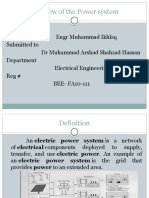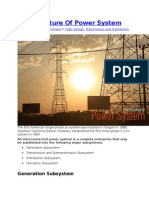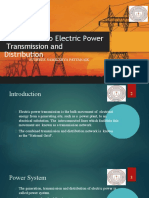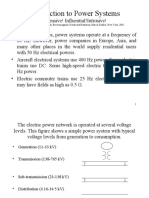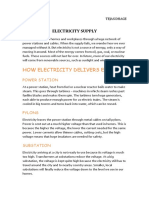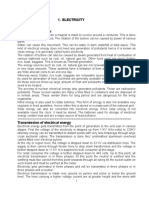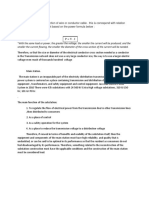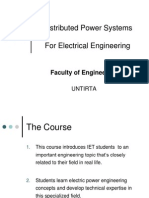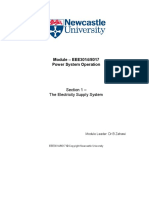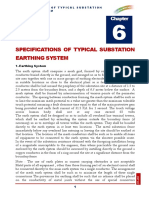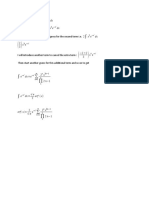ELECTRIC POWER
Chapter
i
ELECTRIC POWER SYSTEM
"DISTRIBUTION SYSTEM
INSTALLATIONS"
1. I.1 INTRODUCTION :
With the advent of need to enormous energies for use in the everywhere
activities of civilized man, there, has been a rapid increase in the production and
usage of electrical energy
The installations of an electric power system thus, serve for :
2. Generation f electric energy at the suitable sites.
3. Transmission of the generated energy to locations of load
centers.
4. Distribution of energy among the individual consumers. All is
being done for the aim of continuous supply of the consumer with
low cost electric energy at the required standard voltages and
frequency, with the admittance of only small specified variations.
I.2 GENERATING PLANTS :
Generators operating at the power stations are the power sources. The
Ch.#I
following types of power generation plants are used :
1
� ELECTRIC POWER
I.2.1 Thermal Or Steam Power Stations :
In a steam power station, fuel (coal or petrol products) gives up its heat of
combustion to boilers which deliver steam at high temperatures and pressures to
steam turbines. The steam loses heat energy in driving the turbines, which are
coupled directly or through gearings to electrical generators. Figure (1) shows a
schematic illustration of a thermal power station arrangement.
Cooling
Air Fuel Water
Feed
Water
Feed Water
Heater
Air Boiler
Preheater
Turbine
Condenser
Generator
Flue gas Ash
Ch.#I
Figure (1)
Thermal power station arrangement
2
�ELECTRIC POWER
I.2.2 Hydraulic Power Stations :
These make use of the costless enormous energy of water falls. Such
water heads operate hydraulic turbines that are coupled to electric generators .
I.2.3 Nuclear Power Stations:
While fuel is the source of heat energy in thermal power stations, it is
made use of the physical principles of nuclear fission to produce heat energy
used in nuclear power stations.
I.4 Transmission Networks :
In order to keep the costs of electric power distribution as low as
possible, it is best to have the generating stations near the center of loads.
However, the necessity to an abundant supply of cooling water for condensers,
the requirement of low cost of fuel transportation or the presence of water falls
are determining factors of the sites of generating stations.
With the advent of high voltage, it became quite reasonable to build
power stations where generation facilities are present and transmit the electric
energy as far as the loads area.
Figure (2) shows a typical AC system, where the power is generated at
13.8 kV very far from the load area transmitted at 380 kV until the reach of the
load area . There, the voltage is stepped down to 132 kV, sometimes to facilitate
the transmission inside the area (e.g. to use 132 kV cables inside a large city) .
The voltage is further stepped down to 33 kV, then to 13.8 kV to feed factories
and into 380 V to feed domestic uses and for street lighting.
With the use of high voltage in power transmission networks, the
following purposes are reached :
Ch.#I
3
� ELECTRIC POWER
1. The voltage level is maintained at the receiving end. This is because, for
the same transmitted power, smaller currents flow in the circuit at
higher voltage. Thus, a smaller value or voltage drop; will be obtained.
2. Smaller power is lost in the transmission network.
This is because of the smaller current flowing in the circuit for a given
power.
13.8 kV 380 kV 380 kV 132 kV
~ E.H.V. Transmission
380/132
Power Substation
Station
132 kV
33 kV
33 kV
Fig. (2) 11 kV
A typical AC system
Medium Voltage
Distribution
Ch.#I
4
�ELECTRIC POWER
3. From the economical point of view, smaller conductor sections are
required for transmitting large powers at higher voltages used.
On the other hand, with the use of higher vo1tage for transmission,
problems are confronted by transmission engineers. Complicated prob1ems of
insu1ation are met with. More and more advanced high voltage equipment and
switchgear are required.
I.5 Distribution Networks:
As the transmitted-energy at high voltage becomes at the reach of the load
area, it is received at step down transformer stations, voltage is stepped down to
the convenient voltages for transmission and distribution inside the area, Fig. (2)
1.5.1 Electric Power Distribution System Schemes And
Installations
For the objective of studying the distribution system operation and
maintenance, a full understanding of networks schemes commonly used is
necessary. Such schemes shall indicate the distribution system installations as
well as the equipment included, where operation and maintenance of the
distribution system will deal with.
For this objective, detailed schemes are presented in Appendix A.I. Ch.#I
5
�ELECTRIC POWER
Fig. (3)
Ch.#I
6
�ELECTRIC POWER
Fig. (4)
Ch.#I
7
�ELECTRIC POWER
Fig. (5) Overhead Lines
Ch.#I
8
�ELECTRIC POWER
Fig. (6) Substation Arrangement – Single Line Diagram
Ch.#I
9
�ELECTRIC POWER
Ch.#I
10
�ELECTRIC POWER
Ch.#I
11



